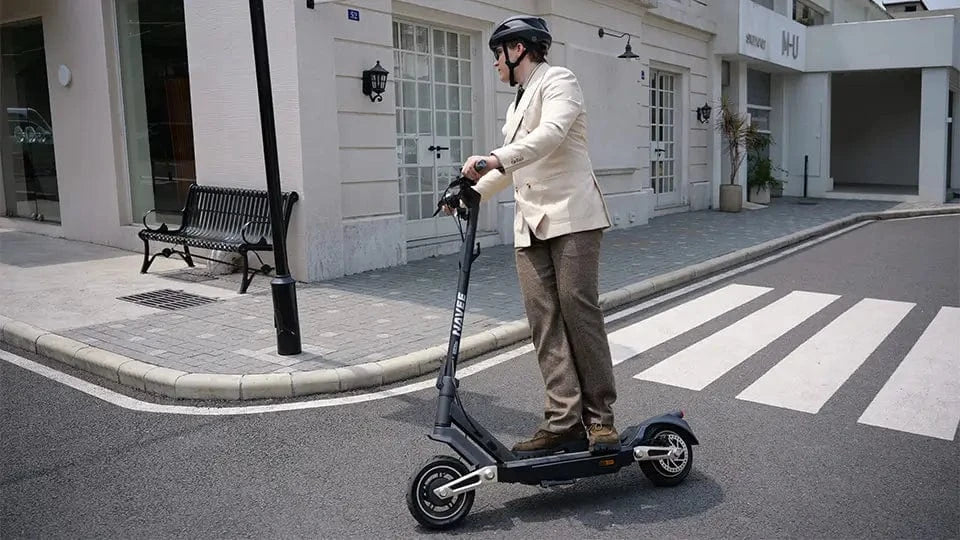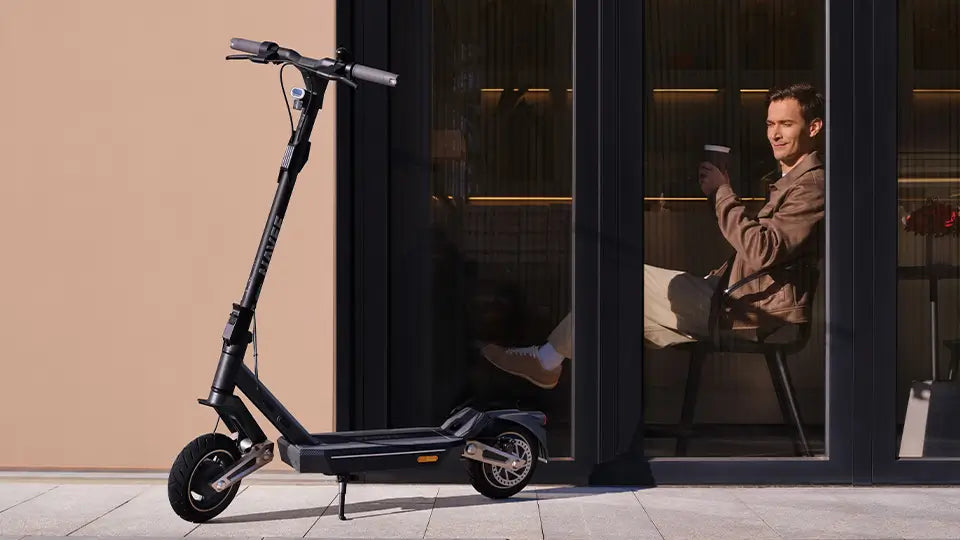When it comes to off-road adventures, the perfect electric scooter is essential to tackling rugged terrain, hills, and unpredictable paths. Whether you're a seasoned off-roader or a beginner looking to explore nature on your electric scooter, selecting the right one can make or break your adventure. In this guide, we’ll cover everything you need to know—features, performance, maintenance, and more—to help you choose the perfect off-road scooter for your needs.
Key Features to Look for in an Off-Road Scooter
Power and Motor Capacity
For off-road adventures, having a powerful motor is crucial. A scooter with at least 500W–2000W of motor power is ideal for handling rugged terrain, steep inclines, and uneven surfaces. Look for high-torque motors to ensure smooth climbing on hills and rough paths.
Recommendation: If you're looking for a high-performance scooter with ample power, the Navee ST3 Pro is an excellent option, offering a 46.6-mile range and a 25 mph top speed.
Tires and Suspension
The tires and suspension system are among the most important features for off-roading. Large, knobby tires (10 inches or more) provide traction and control on dirt, gravel, and mud. Dual suspension or front and rear shocks will absorb shocks and bumps, offering a smoother, more comfortable ride on rough trails.
Recommendation: The Navee N65I offers dual suspension and high-quality tires, making it a great all-terrain scooter for handling various surfaces.
Range and Battery Capacity
Battery life is key when you're venturing far from charging stations. Choose a scooter with a high-capacity battery (600Wh or higher) for 25–40 miles of range on off-road trails. A removable battery can be a great feature for longer trips, allowing you to swap it out for a fresh one when needed.
Recommendation: For long rides, the Navee ST3 Pro offers an impressive 46.6-mile range, making it ideal for extended off-road adventures.

Common Problems Riders Face When Choosing Off-Road Scooters
Overwhelming Number of Models
The electric scooter market is flooded with options, and not all models are suited for off-road riding. Many scooters are designed for urban commuting, so identifying the right model for off-road use can be confusing.
Solution: Narrow your choices by focusing on models that are specifically designed for rugged terrain. Look for scooters with strong motors, large tires, and high suspension clearance. For an excellent off-road choice, consider the Navee ST3 Pro, which is built for demanding conditions.
If you're interested in understanding how off-road scooters handle challenging terrains such as sand or rocky paths, we recommend checking out our All-Terrain Electric Scooters on Sand & Rough Trails: Complete Guide. This guide compares top models like the Navee ST3 Pro and highlights their performance on challenging surfaces, providing essential insights into how these scooters perform in off-road environments.
Power Limitations on Steep Terrain
Riders often worry that a scooter will lack the necessary power to handle steep inclines and rough paths. A motor that is too weak can leave riders frustrated or even stranded on difficult terrain.
Solution: Choose a scooter with at least 500W of motor power. For serious off-roading, dual motors (one on the front and one on the back) offer increased torque for better climbing and traction.
Durability and Build Quality Concerns
Off-road riding puts a lot of stress on scooters. Users are often concerned about the durability of the scooter, especially when faced with obstacles like rocks, mud, and bumpy surfaces.
Solution: Look for scooters made with aircraft-grade aluminum or steel frames. Reinforced suspension systems and waterproof components ensure the scooter can handle rough conditions over time.

How to Choose the Right Off-Road Scooter for Your Needs
Consider Your Terrain
Your choice of scooter depends on the terrain you’ll be riding on. If you’re tackling rocky trails, look for scooters with high torque motors and larger tires for better traction. For gravel paths or muddy surfaces, opt for scooters with deep tread tires for better grip.
Balance Power and Portability
Off-road scooters tend to be heavier due to larger batteries and stronger frames. If you plan to carry your scooter often, consider a balance between power and portability. Look for scooters that weigh between 50–60 lbs for a good combination of durability and portability.
Suspension and Comfort
If you’re riding on rough trails, dual suspension systems (front and rear) will help absorb shocks and make your ride more comfortable. The larger tires will also help in providing additional comfort by smoothing out the bumps.
Budgeting for Your Off-Road Scooter
Price Range and Value for Money
Off-road scooters can be expensive, with prices ranging from $500 to over $2000. When choosing your scooter, consider the long-term value in terms of durability, performance, and safety, not just the initial cost.
Solution: For entry-level off-road riders, look for scooters under $1000. These models provide good off-road capabilities without breaking the bank. However, for serious off-roading, a higher investment in a more premium model is usually worth it.
Hidden Costs – Accessories and Maintenance
Don’t forget about the extra costs that come with owning an off-road scooter, such as helmets, locks, lights, and maintenance tools. Plan for 10–20% of your scooter’s price for these essential items.
Solution: Set aside additional funds for accessories and maintenance. You’ll need items like a repair toolkit for flat tires and maintenance, as well as protective gear for your safety.

FAQ
Q1: What is the best off-road scooter for rough trails?
A: Scooters like the Navee ST3 Pro and Navee N65I are perfect for rough trails. They come with high-powered motors, dual suspension, and wide, knobby tires to handle challenging terrains effectively.
Q2: How long does it take to charge an off-road scooter?
A: Charging an off-road scooter typically takes 6–8 hours depending on the battery capacity. If you need faster charging, look for models with quick-charging capabilities or removable batteries that you can swap out for an extended ride.
Q3: Can off-road scooters be used in wet conditions?
A: Yes, many off-road scooters are designed to handle wet conditions. However, ensure that the scooter has a high IP rating for waterproofing. Always check the weatherproofing details to avoid damage from rain or wet conditions.
Conclusion
Choosing the right off-road electric scooter is a process that involves balancing power, range, durability, and comfort. By considering your specific off-road needs—whether it’s motor power for climbing, high-capacity batteries for range, or the right suspension for comfort—you can find a scooter that enhances your outdoor adventures. Don't forget to factor in maintenance, budget, and safety features to ensure that your scooter can keep up with your off-road explorations.



Share:
The Best Electric Scooters You Can Buy in the USA
What Is the Top Speed of Electric Scooters? Your Complete Guide?